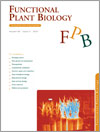
Functional Plant Biology
Volume 39 Number 5 2012
FP11198Is transpiration efficiency a viable plant trait in breeding for crop improvement?
Improved transpiration efficiency is often voiced as a means to increase crop yields in water-deficit environments. In this review, it is shown that transpiration efficiency is a complex characteristic, which limits it use for genetic improvement. Instead, it is concluded that specific plant traits contributing to transpiration efficiency should be studied to increase the effective use of available water for maximum crop growth and yield.
FP11269Partial rootzone drying increases water-use efficiency of lemon Fino 49 trees independently of root-to-shoot ABA signalling
Water scarcity is forcing irrigators worldwide to improve crop water-use efficiency (WUE) by adopting irrigation strategies such as partial rootzone drying (PRD). Although PRD aims to alter ABA root-to-shoot signalling, analysis of the sensitivity of Citrus leaf gas exchange to soil, plant and atmospheric variables showed an ABA-independent enhancement of leaf and crop WUE. Refinement of PRD strategies, based on understanding long-distance chemical signalling, is necessary to maximise PRD's benefits.
FP11237Root traits and δ13C and δ18O of durum wheat under different water regimes
Increasing crop productivity and adaptation to drought are paramount to palliate the challenges imposed by global climate change while securing food production in the future. Roots are of primary importance in plant adaptation to drought but breeding crops for more efficient roots is a difficult task given the nature of such a plant organ, which remains hidden in the soil. This study shows different traits that facilitate the selection of plants with more efficient roots.
FP12020Alternative methods for scaling leaf hydraulic conductance offer new insights into the structure–function relationships of sun and shade leaves
Leaf hydraulic and morphological adaptation to different environmental cues is crucial for plants’ success. We measured leaf hydraulic conductance scaled by leaf surface area, volume and dry weight in sun and shade leaves of Holm oak. Structural changes of leaves acclimating to different light intensities enhance water transport to the unit evaporating leaf surface area, and maintain hydraulic supply to mesophyll cells and carbon costs of the water transport system.
FP12015Water uptake dynamics under progressive drought stress in diverse accessions of the OryzaSNP panel of rice (Oryza sativa)
Genetic variation in rice water uptake patterns may help identify drought resistance mechanisms. In lowland rice lysimeter studies, water uptake dynamics of the OryzaSNP panel under drought were related to root growth at depth. These results reflect the ability of some genotypes to increase root growth at depth during the slow progression of drought stress in lowland soils.
FP11275Identification and characterisation of a novel class I endo-β-1,3-glucanase regulated by salicylic acid, ethylene and fungal pathogens in strawberry
Plant susceptibility/resistance is determined by the rate and magnitude of activation of defence mechanisms, and by its effectiveness against a particular pathogen. The induction of the novel class I β-1,3-glucanase FaOGBG-5 from strawberry infected with a virulent and an avirulent fungal pathogen was analysed and compared with a previously reported class II enzyme. Results suggest that this enzyme is involved in the salicylic acid and the ethylene dependent defence response.
Evaporation of water vapour from leaves is through closable valves in the epidermis (stomata), which respond to the environment and regulate water loss. This paper joins a century-long debate on whether cells inside the leaf can also regulate water loss, by measuring evaporation from leaves stripped on an epidermis, and revealing a daily rhythm of evaporation. This opens new possibilities of controlling plants’ sensitivity to lack of water.
FP11190Is mesophyll conductance to CO2 in leaves of three Eucalyptus species sensitive to short-term changes of irradiance under ambient as well as low O2?
In addition to stomata, mesophyll tissues oppose a resistance to the influx of CO2 during photosynthesis in leaves. We showed, with an approach based on online discrimination against 13CO2 during photosynthesis, that this resistance increases in the short term when irradiance decreases, and decreases oxygen in the atmosphere is switched from ambient to very low values. Such findings are important for understanding the limiting factors of photosynthesis.



